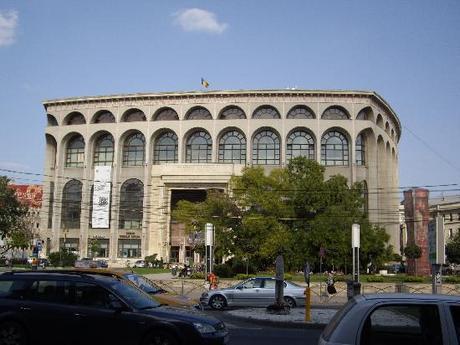National Theater
The stocky building sitting on one of the corners of University Square is the National Theater. It was built in 1973 after plans by a group of Romanian architects. The old building of the National Theater was destroyed during the WWII. Originally the building had a different facade, modeled after the architecture of Moldova's monasteries but in 1984 it was remodeled and got its present massive shape. The theatre has 4 performance halls.
The National Theater is named after the Romanian playwright and short-story writer Ion Luca Caragiale (1852-1912). His plays made fun of the politics and politicians and of the Romanian society of that day. For example the play that is considered to be his masterpiece, "A Lost Letter", written in 1884, describes a provincial government election won by a blackmailer. It's amazing how his works have the same power today as they did a century ago. Not only that, but recently I saw one of his plays being performed in California and I was surprized to see how the American public of today can relate to his story written in 1880.
Last, if you feel like having a refreshment, you'll find two bars located on top of the National Theater. One is a open terrace bar called "La Motoare", open only in summer, while the other one called "Laptaria lui Enache" is open during fall, winter and spring. They are usually crowded, especially in the late afternoon and evening and especially in the summer when it's difficult to find a table before 2AM in the morning. If you find a table, be prepared to share it. At Laptarie you can catch live music most of the evenings.
The National Theatre Bucharest (Romanian: Teatrul Naţional "Ion Luca Caragiale" Bucureşti) is one of the national theatres of Romania, located in the capital city of Bucharest. It was founded as the Teatrul cel Mare din Bucureşti ("Grand Theatre of Bucharest") in 1852, its first director being Costache Caragiale. It became a national institution in 1864 by a decree of Prime Minister Mihail Kogălniceanu, and was officially named as the National Theatre in 1875; it is now administered by the Romanian Ministry of Culture.
In April 1836, the Societatea Filarmonica — a cultural society founded by Ion Heliade Rădulescu and Ion Câmpineanu — bought the Câmpinencii Inn to build a National Theatre on the site, and began to collect money and materials for this purpose. In 1840, Obşteasca Adunare (the legislative branch established under the terms of the Imperial Russian-approved Organic Statute) proposed to Alexandru II Ghica, the Prince of Wallachia, a project to build a National Theatre with state support. The request was approved on June 4, 1840. Prince Gheorghe Bibescu adopted the idea of founding the theatre and chose a new location, on the spot of the former Filaret Inn. There were several reasons to favor this locations: it was centrally located, right in the middle of Podul Mogoşoaiei (today's Calea Victoriei); the earthquake of 1838 had damaged the inn beyond repair, and it needed to be torn down.
The August 13, 1843, report of the commission charged with building the theatre determined that construction would cost 20,300 Austrian guilder (standard gold coins, a sum worth about US$45,000 at the time, of which only 13,000 gold coins were available. In 1846, a new commission engaged the Vienese architect A. Hefft, who came up with an acceptable plan. Construction got under way in 1848, only to be interrupted in June by the Wallachian revolution. In August 1849, after Prince Barbu Dimitrie Ştirbei took power, he ordered that construction be completed. The theatre was inaugurated on December 31, 1852, with the play Zoe sau Amantul împrumutat, described in the newspapers of the time as a "vaudeville with songs". The building was built in the baroque style, with 338 stalls on the main floor, three levels of loges, a luxurious foyer with staircases of Carrara marble and a large gallery in which students could attend free of charge. For its first two years, the theatre was lit with tallow lamps, but from 1854 it used rape oil lamps; still later this was replaced by gaslights and eventually electric lights. In 1875, at the time its name was changed to Teatrul Naţional, its director was the writer Alexandru Odobescu.
The historic theatre building on Calea Victoriei — now featured on the 100-leu banknote — was destroyed during the Luftwaffe bombardment of Bucharest on August 24, 1944 (see Bombing of Bucharest in World War II).
The current National Theatre is located about half a kilometre away from the old site, just south of the Hotel Intercontinental at Piaţa Universităţii (University Square), and has been in use since 1973. It forms part of a complex that also includes the Romanian National Operetta, an art gallery and exhibition space, and several of the city's most prominent bars, including the massive rooftop terrace La Motoare. The theatre is easily accessible from the Otopeni airport.




